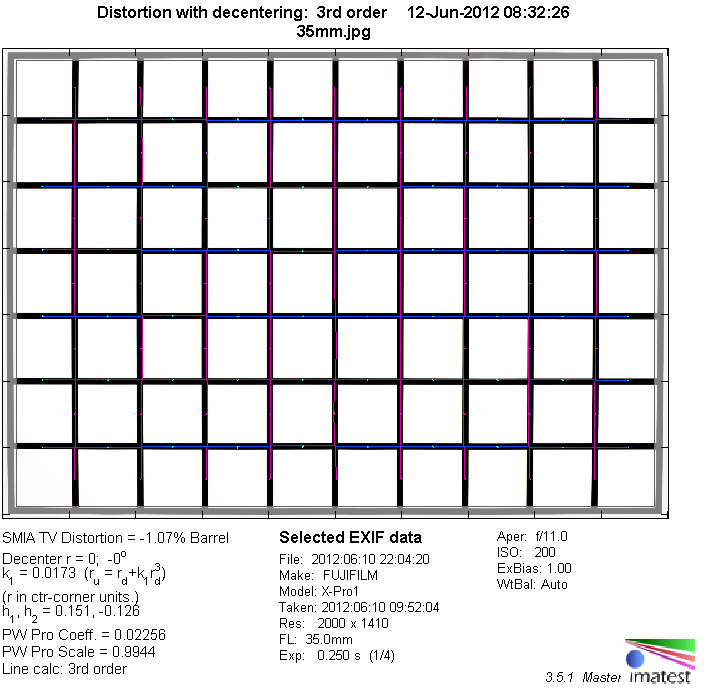|
Fujinon XF 35mm f/1.4 R (Fujifilm) - Review / Test Report - Analysis |
|
Lens Reviews -
Fujifilm X
|
|
Page 2 of 3

Distortion
The Fujinon shows only a tiny bit of barrel distortion which is hardly noticeable. This is also true for RAW files so it is actually a fully corrected lens.

Vignetting
The vignetting characteristic of the Fuji lens is pretty decent considering its focal length and max. aperture. Nevertheless you will still be able to see a light falloff (0.9EV) at f/1.4 in some scenes. The issue is a bit reduced at f/2 and it's mostly gone from f/2.8 onward.

MTF (resolution)
Ultra-large aperture lenses tend to have corner issues at large aperture settings and the Fujinon follows the norm here. The center performance is already great but the outer image region is quite soft both at f/1.4 and f/2. The center quality is outstanding at f/2.8 and the borders/corners are at least lifted to a good level. The peak performance is reached around f/5.6 with a very good quality across the image field. Diffraction effects are visible at f/11 but the results are still very impressive here. The field curvature stays pretty low across the tested aperture range.
The centering quality of the tested (2nd) sample was very good. However, the initially tested sample had a centering defect.
The chart has been updated compared to the initial version. We have moved to CaptureOne for RAW processing. However, the differences are rather marginal.
Please note that the MTF results are not directly comparable across the different systems!
Below is a simplified summary of the formal findings. The chart shows line widths
per picture height (LW/PH) which can be taken as a measure for sharpness.
If you want to know more about the MTF50 figures you may check out the corresponding
Imatest Explanations
Chromatic Aberrations (CAs)
Lateral CA (color shadows at the image borders) are very well controlled with an average pixel width around 0.3px. This is negligible.

Bokeh
A very important aspect of an ultra-large aperture lens is the quality of the bokeh (rendering of the out-of-focus blur). The Fujinon can produce quite nice results here but it is not flawless.
The foreground blur is slightly nervous. The more important background blur is smooth near the image center (shown below) but there's some smearing if you look more towards the borders of the image field (see also some sample images on the next page).
 Out-of-focus highlights have a slightly uneven inner zone. There's a marginal outlining effect here at f/1.4 which gets somewhat emphasized the more you stop down. The highlight discs are circular in the image center but the shape deteriorates the more you watch towards the image borders. Stopping down improves these cat’s eyes towards a circle and the circular shape remains intact till f/2.8 where you can start to spot traces of an edgy aperture shape.
Out-of-focus highlights have a slightly uneven inner zone. There's a marginal outlining effect here at f/1.4 which gets somewhat emphasized the more you stop down. The highlight discs are circular in the image center but the shape deteriorates the more you watch towards the image borders. Stopping down improves these cat’s eyes towards a circle and the circular shape remains intact till f/2.8 where you can start to spot traces of an edgy aperture shape.

Bokeh Fringing / Longitudinal Chromatic Aberrations (LoCA)
Bokeh fringing is a common issue with fast glass. It's visible as halos of different colors in out-of-focus areas - magenta (red + blue) in front of the focus point and green beyond.
The XF 35mm f/1.4 shows noticeable bokeh fringing at large aperture settings which can of be reduced by stopping down. The effect remains slightly visible even at f/2.8 but it is basically gone from f/4 onward.
|
Move the mouse cursor over the f-stop marks below to observe the respective LoCAs
|
| f/1.4 |
f/2 |
f/2.8 |
f/4 |
|

|
|